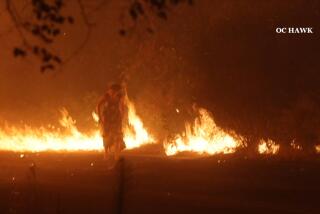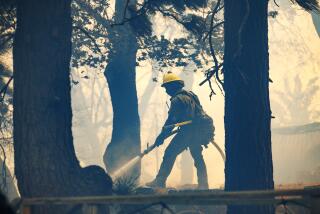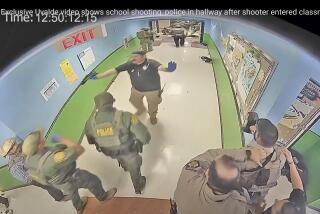San Bernardino medic had 5 seconds to check if each massacre victim was alive or dead
As the water raining down from the overhead sprinklers pooled in rivers of blood and the smell of gunpowder hung in the air Wednesday, Ryan Starling remembered his training.
He got out his white tape.
More than two dozen victims lay on the floor at the Inland Regional Center, the 33-year-old medic recalled Tuesday.
Starling began moving from body to body to determine who might survive.
“In five seconds, you look at their skin color, their breathing and you feel their pulse,” he said. “By all those things, you are determining if they are critical or deceased.”
He marked the dead with white tape so he and other rescuers could focus their efforts on the living.
Just minutes earlier, Starling and his SWAT teammates had been training for just such a grim task — conducting active shooter drills less than 10 miles away.
He said that when the first shooting reports arrived, his specialized team, already armed and dressed, switched out blanks for real rounds in their assault rifles and rushed to the scene.
Starling expected to be the first paramedic to arrive, and he knew that other medical personnel would be ordered to wait at a safe distance in keeping with standard policy intended to keep firefighters safe.
As a medic attached to a SWAT team, Starling wasn’t bound by that rule. He would be going in.
Coordinating with police and sheriff’s deputies, the SWAT team worked first to clear civilians out the first floor of the southernmost building on the campus.
The team also searched room by room for any signs that the shooters might still be nearby.
By then, though, the assailants, Syed Rizwan Farook and Tashfeen Malik, had fled, subjects of a manhunt that would end hours later in a massive shootout.
As the SWAT team crawled slowly through the building, Starling and a fellow SWAT officer broke off from the others and approached the conference room.
He could see that a holiday party had been underway. He found the scene both grotesque and strangely ordinary.
A table of pastries sat by the front door, untouched, while water rained down from the sprinklers. The carpet was soggy.
He could hear voices, crying, screaming and moaning of the victims. He couldn’t say how many were hurt. Perhaps more than two dozen, he thought.
Starling put aside his emotions and got to work. He needed to separate the living from the dead. He pulled on gloves and took a roll of white tape from his vest.
He moved with practiced precision, five seconds to assess skin coloring, breathing and pulse, all factors he used to determine the victim’s chances for survival. He started tearing off pieces of the tape.
Fontana Police Cpl. Mike Ernes, a member of the second team into Inland Regional Center, was working in the conference room as well.
Ernes felt terrible walking past some victims to reach others who were in greater need, “one of the worst things I’ve ever had to experience in my career,” he remembered later.
Starling started giving orders. He told police which of the wounded to take outside to the parking lot.
Joining them outside, Starling opened his medic bag, filled with medication and gauze, and directed officers to begin bandaging the victims before police cruisers ferried them to ambulances beyond the perimeter.
San Bernardino Fire Battalion Chief Grant Hubbell had helped set up a triage site at Waterman Avenue and Park Center Drive.
There, medics waited for victims.
One of the worst things I’ve ever had to experience in my career.
— Fontana Police Cpl. Mike Ernes
With the wounded removed from the conference room, the SWAT team again combed the building. When what looked like a pipe bomb was discovered, the team evacuated until it was safe again to go back inside.
Soon, two suspects were spotted elsewhere driving in a black Ford Expedition.
The final shootout took place about three miles from the Inland Regional Center. San Bernardino County Sheriff’s Deputy Shaun Wallen, one of the closest officers to the SUV, exchanged gunfire with Farook.
As he did, San Bernardino city police Officer Nicholas Koahou got out of his vehicle to give Wallen cover and was hit in the left thigh. It felt as if he had been punched in the leg.
Falling to the ground, Koahou heard the gun battle rage as more than 400 shots were exchanged. Then there was silence.
Starling and his team had been called in during the shootout. Now he stood over the bodies of Farook and Malik and declared them dead.
A week later, the acting deputy fire chief for the city of San Bernardino, Dan Harker, is proud of his department’s response.
But the accomplishment comes with a sense of regret: Under its plan to emerge from bankruptcy, the city voted this year to disband the 137-year-old Fire Department and outsource fire services to the county.
“It’s a little solemn, thinking we did such a great job and now this department may go away,” Harker said.
In much of the country, fire rescuers are held back in safe “cold” zones, waiting for law enforcement to clear “hot” areas where gunmen are active.
Only an elite group of firefighters like Starling, trained to embed with SWAT teams, enter active scenes. Starling is the only medical employee in that category in the San Bernardino Fire Department, officials said.
But Wednesday’s shooting was an exception.
Greg Soria, a captain with the San Bernardino Fire Department, and his team decided to join Starling and enter the building before it was secured.
“They needed help in there,” Soria said. “We went ahead and made entry.”
Recommendations issued by the Federal Emergency Management Agency in 2013 call for changes so that all fire department medics, working with police, can enter “warm zones” — areas near active shooters where a threat might exist — before the attackers have been fully subdued.
“It is almost unacceptable to stand back any more,” said E. Reed Smith, medical director of the Arlington County Fire Department in Virginia and an advisor on the federal government’s new guidelines. “The citizen expects us to go to work.”
Smith said that the proximity of San Bernardino’s SWAT team, with its trained medic, resulted in a “lucky break” that probably saved lives.
U.S. Fire Administrator Ernest Mitchell, the nation’s top fire official, echoed Smith’s call to speed up medical responses to victims of shootings. But in an interview with the Los Angeles Times, he offered praise for the performance in San Bernardino.
“I think what they did is they improvised with the tools they had available and that’s great,” he said.
San Bernardino Fire Capt. Mike Arviso agreed. If the medical help hadn’t arrived as quickly as it did, there would have been possibly four or five more fatalities.
“Obviously we don’t know,” Arviso said, but having Starling near the scene “probably kept them from bleeding out.”
Starling thinks that more than simple luck was at play.
“I believe it was divine intervention,” Starling said.
Times staff writers Matt Stevens and Richard Winton contributed to this report.
MORE ON SAN BERNARDINO
Customers rush to gun stores to ease fears after San Bernardino shooting
San Bernardino shooters began plotting attack before their marriage, FBI chief says
One brother hatched a terrorist massacre, the other served his country in the U.S. Navy
More to Read
Sign up for Essential California
The most important California stories and recommendations in your inbox every morning.
You may occasionally receive promotional content from the Los Angeles Times.














